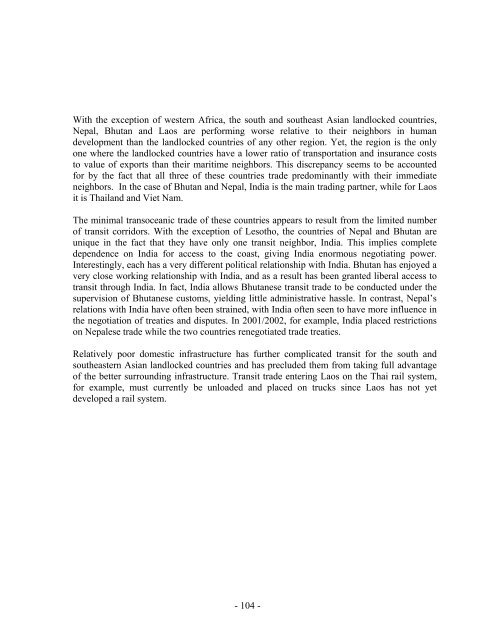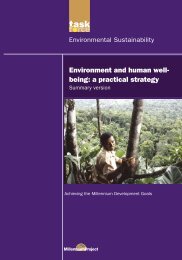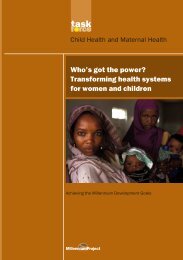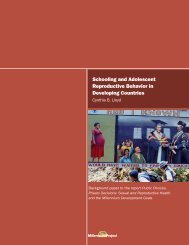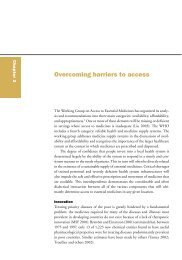the challenges facing landlocked developing countries: a case study ...
the challenges facing landlocked developing countries: a case study ...
the challenges facing landlocked developing countries: a case study ...
Create successful ePaper yourself
Turn your PDF publications into a flip-book with our unique Google optimized e-Paper software.
With <strong>the</strong> exception of western Africa, <strong>the</strong> south and sou<strong>the</strong>ast Asian <strong>landlocked</strong> <strong>countries</strong>,<br />
Nepal, Bhutan and Laos are performing worse relative to <strong>the</strong>ir neighbors in human<br />
development than <strong>the</strong> <strong>landlocked</strong> <strong>countries</strong> of any o<strong>the</strong>r region. Yet, <strong>the</strong> region is <strong>the</strong> only<br />
one where <strong>the</strong> <strong>landlocked</strong> <strong>countries</strong> have a lower ratio of transportation and insurance costs<br />
to value of exports than <strong>the</strong>ir maritime neighbors. This discrepancy seems to be accounted<br />
for by <strong>the</strong> fact that all three of <strong>the</strong>se <strong>countries</strong> trade predominantly with <strong>the</strong>ir immediate<br />
neighbors. In <strong>the</strong> <strong>case</strong> of Bhutan and Nepal, India is <strong>the</strong> main trading partner, while for Laos<br />
it is Thailand and Viet Nam.<br />
The minimal transoceanic trade of <strong>the</strong>se <strong>countries</strong> appears to result from <strong>the</strong> limited number<br />
of transit corridors. With <strong>the</strong> exception of Lesotho, <strong>the</strong> <strong>countries</strong> of Nepal and Bhutan are<br />
unique in <strong>the</strong> fact that <strong>the</strong>y have only one transit neighbor, India. This implies complete<br />
dependence on India for access to <strong>the</strong> coast, giving India enormous negotiating power.<br />
Interestingly, each has a very different political relationship with India. Bhutan has enjoyed a<br />
very close working relationship with India, and as a result has been granted liberal access to<br />
transit through India. In fact, India allows Bhutanese transit trade to be conducted under <strong>the</strong><br />
supervision of Bhutanese customs, yielding little administrative hassle. In contrast, Nepal’s<br />
relations with India have often been strained, with India often seen to have more influence in<br />
<strong>the</strong> negotiation of treaties and disputes. In 2001/2002, for example, India placed restrictions<br />
on Nepalese trade while <strong>the</strong> two <strong>countries</strong> renegotiated trade treaties.<br />
Relatively poor domestic infrastructure has fur<strong>the</strong>r complicated transit for <strong>the</strong> south and<br />
sou<strong>the</strong>astern Asian <strong>landlocked</strong> <strong>countries</strong> and has precluded <strong>the</strong>m from taking full advantage<br />
of <strong>the</strong> better surrounding infrastructure. Transit trade entering Laos on <strong>the</strong> Thai rail system,<br />
for example, must currently be unloaded and placed on trucks since Laos has not yet<br />
developed a rail system.<br />
- 104 -


